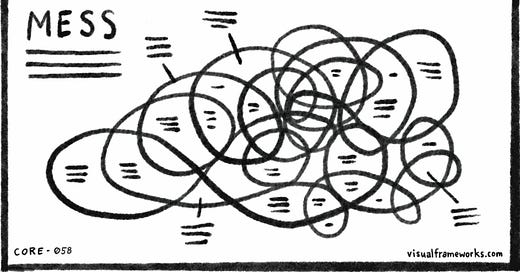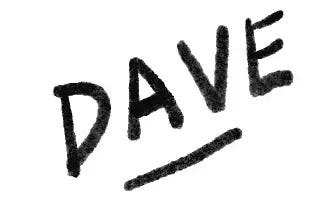The Monday memo is food for thought to fuel your week.
You sit down to write, but nothing is coming. You are waiting for the perfect opening line, the ideal structure, the flawless argument. The page remains stubbornly blank.
Consider this: the first draft doesn’t need to be good. It just needs to exist. Because it’s a stepping stone to what comes next.
One paradox of creativity is that you have to write badly before you can write well. Think of your first draft as raw material, not finished product. Clay before sculpture. Marble before Michelangelo. The goal isn’t perfection. It’s permission to begin.
There is a voice inside your head, an inner narrator, and before you can write you need to learn to listen to that voice. That inner narrator is continuously paying attention to your surroundings, making sense of what’s going on. At night it makes up dreams and plays them on your inner screen. For some of us that inner narrator is a chatterbox. It won’t shut up! And your inner narrator is unique to you, with a special, idiosyncratic, original perspective on the world that is unlike anyone else’s.
And yet when it comes time to write… crickets. That’s because in addition to having an inner narrator, you also have an inner critic.
Having an inner critic is generally a good thing, because saying your thoughts out loud as you have them can create some socially awkward moments. I’ve definitely been there, saying something out loud and then noticing the reaction: somebody’s face falls, the room goes silent, and there I am thinking, “Oops. I wish I hadn’t just said that.” I’m sure you’ve been there too.
But that inner critic, who protects you from socially awkward situations, becomes a problem when it’s time to write.
Think of your inner narrator and inner critic as partners. The narrator creates the thoughts, and the critic judges the thoughts.
For the narrator to find a path, play on the page, feel free to speak, the critic has to get out of the way.
One way to begin is simply to think of yourself as a stenographer. Listen to your inner narrator and simply start writing down your stream of consciousness, without judgment. The trick is to get the critic out of the room. Remember, nobody ever has to see what you’re writing. It’s just for you.
The first draft is simply a space for you to tell a story to yourself, putting words on a page, so you can have something to work with. You’re creating raw material.
When you give yourself permission to write badly, you give your ideas permission to start flowing. You can discover what you're actually trying to say by saying it imperfectly first. You can't edit a blank page, but you can absolutely improve a messy one.
Your first draft is a conversation with yourself, not a performance. It's where you figure out what you think, not where you demonstrate how smart you are. The polishing comes later. Your first job is simply to fill the page.
How can you know what you think until you see what you say?
Exercise.
Here’s your exercise for the week. Choose a topic that's been on your mind: work, relationships, something you’ve been meaning to figure out or wanting to write about. Write continuously until you have filled four pages. Don’t stop to edit, don’t worry about grammar, don’t second-guess yourself. Just let the words flow.
If you get stuck, write “I’m stuck” and keep going. If you repeat yourself, let it repeat. If it’s terrible, let it be terrible. The goal is volume, not perfection.
When you’re done, put it away for a day. Then come back and read it. You might be surprised by what you find buried in that mess: ideas you didn't know you had, connections you didn't expect, a voice more authentic than your careful, edited self.
Don’t write to impress. Write to discover what you have to say. Write proliferously, write continuously, write generously, write imperfectly, write carelessly, write badly. Just write.
See what happens.
Summertime experiments.
Project Kairos. I’m exploring the narrative arc for our fall semester. It will be all about timing, time-boxing, deadlines, and ways that we can warp and bend time to organize our creative work, get motivated, and sustain momentum. I’ve already spoken to a few of you and it’s already generating interesting ideas. If you have time for a 1:1 chat to help me think through the fall semester, please send me a note so I can hear your thoughts, and we can talk about how I can make it work for you.
Both/and book club. Erin Rodat-Savla and Karen Brothers are hosting a business book club where the group reads two books with contrasting points of view. Half the group reads one book, half reads the other, and we compare notes. We have already begun, but you can probably still join us. If the description above sounds like you, you can register your interest here.
Vibe club. Vibe club is a regular meetup focused on “mutual interests around AI + coding + related vibing activities—design, art, marketing, venturing,” so reach out to Dan if you want to be part of that.
Procreate club. Procreate is an iPad app for digital art. I’ve used it to design t-shirts, posters, and even a card deck. If you have an iPad and want to get better at drawing, I’m hosting some time to play together every Monday at noon Pacific, 3 PM Eastern, 8 PM BST and 9 PM CET. Here’s a link to register which will allow you to add this recurring event to your calendar.
There are more ideas floating around on the summertime board so please check it out and add your thoughts.
And I’ve got more time this summer which means more time for 1:1 calls. So please do send me a note if you’d like to chat.
See you soon!






So true. Bold first word, bold first brush stroke, bold first step. Yes, it needs courage sometimes. Thanks for the encouragement 👌🏽